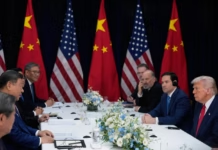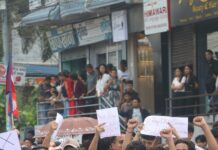After Legco is stormed government prepares to launch massive counter-offensive
Dikang, Socialist Action (CWI in Hong Kong)
On July 1, the 22nd anniversary of the handover and a traditional day of mass anti-government protest, Hong Kong’s mass struggle against the unelected government’s extradition law entered a new phase. For almost a month the government and Hong Kong’s state apparatus have been thrown into unprecedented crisis by mass protests which are equally unprecedented in scale and intensity. A state of total government paralysis has reigned. But this dynamic has changed – to what extent is not yet fully clear – with the events of July 1, which have given Carrie Lam’s punch-drunk administration an opportunity to steady itself and begin to hit back.
The storming of the Legco (Legislative Council), which predictably the Chinese dictatorship (CCP, so-called Communist Party) and Hong Kong’s rabid right-wing pro-government camp have seized upon to launch a major political counter-offensive, raises crucial questions about how the mass movement should organise itself to go forward. This incident, broadcast live on television, involved a small section of the youth driven to desperation by what appears to be a stalemate in the struggle, with the government stonewalling on meeting any further demands.
The government’s stand has produced unprecedented mass anger but even despair among sections of the population, especially the youth, and a readiness to throw everything into the struggle, even life itself. At least three young people have committed suicide in the past three weeks leaving anti-government notes and messages. It’s feared more may follow.
It seems clear now that the youth who stormed into the Legco building were lured into a trap set by the police, probably supported by CCP agents, launching into an unplanned and chaotic action that the regime and Hong Kong’s pro-government camp hope they can squeeze maximum propaganda value from in order to discredit the mass struggle. The CCP-state and its various agencies have a long track record of such cynical, shadowy manoeuvres.
In the face of what, after the events of July 1, is likely to be even greater government intransigence towards meeting any of the central demands of the movement, with police stepping up repression and arrests, the movement has come to an important, even critical, crossroads.
Socialist Action believes the struggle can still produce a major and historic victory over the government and CCP dictatorship, but this will require a higher degree of organisation and coordination, more democratic discussion over strategy, tactics and aims, and in particular more discussion about the unused weapon of the mass strike, to bring the power of collective working class action into this battle for the first time. From a ‘leaderless’ movement the situation now cries out for clear leadership, to pull the entire struggle behind a winning strategy. This is the way forward to victory.
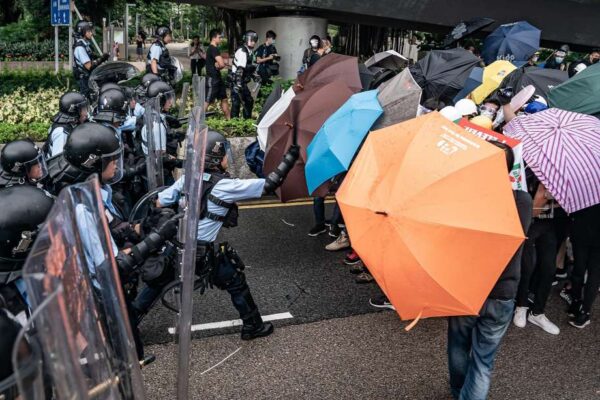
Biggest ever ‘7/1’ demonstration
Around 550,000 joined the annual Civil Human Rights Front demonstration on July 1 [a tradition that began in 2003, a victorious mass protest that defeated the government’s attempt to introduce repressive ‘Article 23’ national security legislation]. While dwarfed by the turnout of one million on June 9, and almost two million on June 16, this year’s turnout made it the biggest ever ‘7/1’ demonstration. A degree of tiredness among the broad masses and questioning of the effectiveness of ‘another’ monster demonstration, undoubtedly limited the numbers to ‘massive’ rather than ‘historic’.
Mass frustration and anger have grown as the government continues to turn a deaf ear to the five main demands of the movement, which are the complete withdrawal of the extradition law (it has only been ‘suspended’), an independent public investigation into the police violence against young protesters on June 12, the release of those arrested then (around 30) and the dropping of ‘riot’ charges which can lead to ten years imprisonment. The final demand is the resignation of Carrie Lam, the Beijing-appointed Chief Executive.
Read more ➳ How long can Hong Kong’s “zombie” leader Carrie Lam cling to power?
The entire government machinery has been paralysed since the June 9 and June 12 demonstrations, with no meetings of the main policy-making Executive Council for two weeks (prior to July 1). Serious public splits and recriminations have opened up in the pro-Beijing political parties [these serve as a support base and buffer for the government]. Lam, the chief villain of this drama, disappeared from public view for almost two weeks until delivering the Chief Executive’s traditional July 1 speech, which set a record for brevity (less than six minutes) at a ceremony that had to be shuffled indoors because of the protests on the streets nearby.
Still in office?
In almost any other capitalist society the government would have fallen by now. Yet seemingly despite its complete humiliation by mass protests that have demolished any last ounces of ‘legitimacy’, Lam’s government has defied the laws of political gravity. This realisation is contributing to the anxiety and frustration of the masses and the youth: What more is needed to kill this monster?
From the standpoint of the capitalist class, who the government ultimately serves, the best course of action would already have been for a leader so badly damaged and discredited as Lam to ‘fall on her sword’ and make way for a new face, a change from one pro-business administration to another, offering some short-term concessions to buy time and demobilise the mass movement.
But the Hong Kong capitalist class do not have this power to replace by their own actions a defective government. That power rests with the Chinese dictatorship, which for now at least is insisting Lam must remain in office for fear of the political Pandora’s Box her resignation would open.
As during the Umbrella Revolution [a 79-day occupation in 2014], what makes Hong Kong’s political crisis different, ‘abnormal’ by world standards, is the role of the Chinese dictatorship, the ultimate power in the territory, which has blocked any even minor democratic concessions because it fears the impact of such ‘weakness’ spreading into China. This applies both at the top and below: an acceleration of the elite-level power struggle challenging Xi Jinping’s ‘strongman’ position, and encouragement to the Chinese masses to struggle against worsening authoritarianism and economic austerity.
The decision, which was of course ultimately made by Beijing, to suspend the extradition law was a very significant, even exceptional, partial retreat for a dictatorship that “doesn’t do retreats”. This, however, does not satisfy the concerns of Hong Kong’s people, especially the youth, who are familiar with Beijing’s playbook: manoeuvres, fake concessions, and delaying tactics, followed by a merciless counter strike once mass pressure has abated.
Military threats
The Chinese dictatorship is clearly stepping up its pressure on the struggle in Hong Kong, both to intimidate the masses and in part also to shock its local Hong Kong appendages into getting a grip. The 5,000-strong People’s Liberation Army garrison in Hong Kong, just a few hundred metres from the Legco, held military drills on June 26. The drill was not reported until after the clashes on July 1, when the news was published in the mainland’s PLA Daily newspaper.
Read more ➳ Hong Kong’s one million march – political strike is the way forward
This drill was clearly aimed partly at an internal audience, fed on the CCP’s “foreign conspiracy” narrative, to show the various factions within the CCP-state that the army is prepared to flex its muscles if needed. But it was also aimed as a warning to the movement, a “blatant message about the use of force,” according to one expert on military affairs quoted in the South China Morning Post.
At this stage, direct military intervention by the Chinese state is extremely unlikely. Even as the CCP fumes over the refusal of the Hong Kong people to passively submit while the ‘one country, two systems’ model of partial autonomy is dismantled, a direct military occupation of Hong Kong would be a fateful high-risk step, with the potential for blowback on many fronts. It would deal a possibly fatal blow to any remaining hopes the CCP has for ‘peaceful’ reunification with Taiwan. Not even the most China-loyal Kuomintang politician in Taiwan would publicly support this idea in the event of a PLA military intervention in Hong Kong.
The international climate has also changed radically even since the days of the Umbrella Movement. Today, an escalating ‘cold war’ between China and the United States, which goes far beyond a still deadlocked trade war with Donald Trump’s administration, means that direct Chinese military intervention in Hong Kong could explode into a Crimea-style international crisis, or worse, with Western capitalist governments using this as a pretext for more anti-China economic protectionism and a push to isolate the Chinese regime in international forums.
A potentially much more serious problem for the CCP would be the resistance of the people themselves. Hong Kong is not Crimea, with its much smaller population, and while militarily China’s hand is overwhelming, ruling Hong Kong in the aftermath of using military force could become an even bigger nightmare for the CCP.
Spread the struggle to China
But the role of the Chinese dictatorship, which acts as a seemingly impregnable backstop for its Hong Kong marionette regime, no matter how weak and crisis-ridden the latter becomes (as in 2014 when for a short period CY Leung’s regime was seriously wobbling), is the real source of mass frustration in Hong Kong today.
Hundreds of thousands who have participated in the demonstrations, and tens of thousands of youth who are energetically interacting through online forums over how and where to mobilise, are becoming more and more perplexed: How can we win this struggle? It seems as if the movement has “tried everything” – never before have such huge numbers come out, achieving miraculous feats of mobilisation, but the structure does not give, the battle is not equal… This is because of the gigantic footprint of China’s dictatorship on the situation.
Socialist Action (CWI) in Hong Kong has consistently explained that to win, the movement for real democratic rights and against the pro-billionaire agenda of the Hong Kong government has to spread to China, to link up with the mass discontent developing in mainland society especially among the working class. The workers, more than 500 million-strong and whose strike struggles have grown more numerous in recent years, they are the force that puts fear into Xi Jinping and the dictatorship.
There is no bigger problem facing the Hong Kong struggle today than how to break out of single-city isolation and act as a spark for a bigger movement across China and the wider region which would ‘level the playing field’ in fighting the dictatorship. If the protests in Hong Kong began to speak up forcefully, carry placards and raise slogans calling for China’s masses to join a common struggle against dictatorship, this could get a massive echo from the masses in mainland China and escalate the pressure on Beijing.
The issues in China and Hong Kong, police repression and arrests, lack of democratic rights, chronic and worsening inequality, lack of affordable housing, dead end jobs for young people, a dictatorship of billionaires, these are the same only in most cases much worse in mainland China.
A leaderless movement
At the time of writing, Hong Kong’s crippled government and pro-Beijing political establishment are being drilled and shaken into some semblance of composure by the Chinese regime, to exploit the ‘gift’ of the Legco incursion and launch a counter strike against the mass movement.
That the CCP is directing these manoeuvres is not in any doubt. Vice premier Han Zheng, the top Hong Kong hand on the Politburo Standing Committee, has this week again been reported in Shenzhen, from where he can give orders to Lam and her government. The regime’s counter strike will firstly take the form of propaganda, a typhoon of propaganda, against “violent” and “extreme radical” protests. The police, who have been on the back foot since their day of infamy on June 12, are also resuming the offensive now with arrests of alleged Legco occupiers based on photographs from media and surveillance cameras, and greater readiness to again use gas and other repressive weaponry at future protests.
The mass movement needs to adopt new methods in order to meet this challenge. Much has been made of the leaderless, spontaneous and decentralised character of the protests so far. This is a correct description.
Spontaneity and mass initiative can play a very positive role, a decisive role in some struggles. But in general, the lesson of all previous mass movements – those that have succeeded and those that have been defeated – shows that spontaneity has limits. It can play a powerful role especially at the start, but as struggles become more complicated, as the enemy also adapts its strategy, the key to success is organisation and a clear strategy and programme for the struggle.
This view has become unfashionable in recent years, which is the result of many complex factors that socialists have analysed in other material. But in Hong Kong today, at this important juncture in the struggle, the issue of organisation and forums that allow organised democratic discussion on the way forward will prove decisive.
That the current Hong Kong struggle, especially among the youth, has been ‘leaderless’ is not in the first instance a matter of choice, although many young activists believe – wrongly in our view – this to be a superior method for conducting the struggle. The repression of the past four years, with at least 48 government-instigated trials involving several hundred activists, has sent over one hundred to jail, with the heaviest blows aimed at the more radical pro-democracy parties and groups.
Read more ➳ Hong Kong: Mass outrage at police violence
For the government, the downside is that there are no ‘leaders’ to negotiate with, which in reality means to pressure into accepting bad ‘compromises’, deploying their usual tricks for defusing mass protests. Even when released from prison, as with Joshua Wong of student group Demosisto who completed his sentence in time to join the mass protests in June, being a prominent media figure is no guarantee of influence in the movement today.

What kind of struggle?
A de facto division of labour has emerged with the Front (CHRF), which groups together most pan-democratic parties and organisations including unions, calling the main marches as on June 9, 16, and July 1, and handling most press communications, while the informal online networks of youth innovate and mobilise for more radical protests and confrontation with the authorities.
This situation is problematic for a number of reasons, and is rooted in the weakness of genuine mass organisations, a historical feature of the Hong Kong democracy struggle. In general, around the world, the degree of mass organisation is directly correlated to the traditional strength of the working class and its organisations such as trade unions. This is the case even where, as is the case in most countries, workers’ organisations have suffered setbacks and been pushed back by the capitalists and their governments in recent years. The numerical weakness of trade unions and workers’ organisations in Hong Kong is an important complicating factor in the current struggle.
The Front and the pan-democratic politicians openly declare they have no ambition to lead or share real responsibility for the actions of the more militant youth, but offer them their support. This is also a reflection of the diminished authority of these leaders and parties especially since the deadlocked outcome of the Umbrella Revolution and subsequent repression. After calling the biggest back-to-back demonstrations in Hong Kong’s history this June, the Front, while fully acknowledging the need for ‘escalation’, admits that it doesn’t know what to do next.
On the other side of the equation, the youth, while showing tremendous initiative, creativity and not least courage in facing down the state machine, tend to regard the traditional mass marches organised by the Front as a separate department, which are best left to the Front and the pan-democrats. In part, many young activists don’t see mass marches as the main focus as these marches have “failed” to defeat the government and bring about democratic change. Reflecting an unconscious anarchism, the youth layer are generally sceptical towards the idea of organising a political force within the struggle.
Neither wing of the current movement express the ambition to unify their respective departments into one more powerful and more organised whole. Unfortunately, this type of de-centralisation, seen as a plus by many in the current struggle, raises the danger of fragmentation, of possible serious divisions at a certain stage, and this could increasingly become a barrier to the struggle going forward. In a word, what is needed is leadership.
By this we do not mean the top-down imposition of leadership as became the case de facto during the Umbrella Revolution. Many youth for good reason are distrustful of the pan-democratic politicians and also the Front which does not have democratic, open structures. Real fighting leadership for the mass movement has to be built democratically from below, by organising the grassroots activists.
Democratic discussion and planning
Today’s young protesters network online, mostly anonymously through encrypted messaging apps. Their fear that being identified at protests and caught on surveillance cameras can lead to arrest and prosecution is reasonable. This is the result of the government’s importation of mainland China’s repressive methods. There has been a trend among workers in China for several years not to elect representatives openly when embarking on workers’ struggles and strikes, because these spokesmen and women are the first to be arrested and dismissed by the company.
In an increasingly authoritarian society, which Hong Kong has become, the youth have no choice but to adopt such measures. But there is a different between the need on one hand to use semi-underground methods of organisation and to protect the identity of protesters, and on the other hand entrusting spontaneous and often unplanned actions to be sufficient to defeat a government underwritten by such a powerful dictatorship.
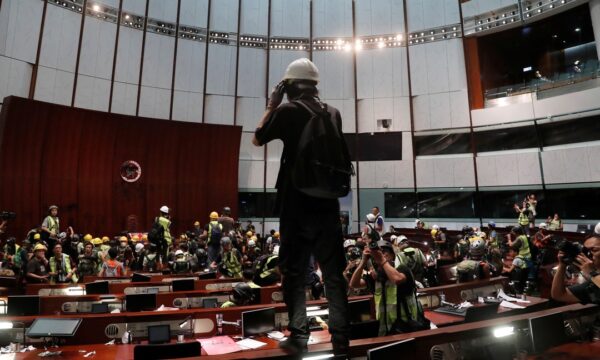
The crying need is therefore for full and democratic discussion over the methods, tactics, and political aims that the movement will need to go forward. Such discussion, and votes whenever different positions arise, can only take place if mass organisations are built during the course of the current struggle. Online chat groups do not offer a genuinely democratic forum for this type of debate and discussion, despite the illusions some people have on that score. A monsoon of random and disconnected posts, each referencing different problems at the same time, makes structured and organised discussion impossible. The result is not a clear plan of action. Online voting in these conditions is confusing and not rooted in democratic discussion.
There is a need for anti-extradition law committees, democratically run and open to all who want to engage in active struggle, in every school, workplace and local community. We believe that the various forces involved in the movement such as the Front, the Hong Kong Confederation of Trade Unions (HKCTU), student and youth groups and other interested parties should call for a one-day conference of all groups and sections of the movement. The theme of such a conference should be how to provide stronger organisation for the struggle, through the creation of democratic committees to enable a strategy and tactics to be hammered out democratically.
Organise for a real one-day political strike
A key component of any successful strategy must be the issue of a one-day political strike. This is the glaring omission from the struggle to date. A discussion should start with honest analysis about why no strike, in the real sense of that word, has been organised despite extensive talk about this.
The weaknesses and limitations of trade union organisation in Hong Kong are no secret. What can be done to change the situation? How can huge non-unionised layers be encouraged to organise? How can the current movement’s demands be linked to the issues facing workers and professional groups on a daily basis: the longest working hours in the world, stagnating real incomes, privatisation and ruination of public services, the government’s refusal to finance a universal pension system.
The struggle today is being frustrated and held back by this blockage on the industrial plain – the failure of organised labour to come to the fore and blast a way through the government’s intransigence by closing down the economy, even for one day, and serving notice of further action unless the demands of the struggle are met. World politics is full of examples of workers’ mass strikes being the decisive weapon against authoritarian regimes: South Korea, South Africa and Brazil in the last century, the mass struggle in Sudan today.
After June 9 there was an upsurge of discussion around the strike issue, again largely spontaneously, but unfortunately with almost no leadership or direction given by the HKCTU or its most significant constituent parts such as the PTU. Socialist Action was until the June 9 demonstration the only organisation in Hong Kong agitating for a general strike, distributing over 35,000 leaflets for the strike in various demonstrations.
Even in overseas media the ‘strike’ in Hong Kong was reported as a fact, based on press releases, social media posts and a generous helping of misunderstanding. Some small businesses did close for June 12 and on other protest days, but this was a very small-scale affair. The Front called for a strike, then cancelled its call, then after the huge turnout on the June 16 demonstration, reinstated its call for a “rally for a strike” on the following day. This was very last-minute and disorganised.
Read more ➳ Is the US promoting a “colour revolution” in Hong Kong?
The HKCTU’s press conference for a ‘strike’ was unfortunately anything but. Union spokesmen said workers should ask their employers for permission to take some hours off to attend protest rallies. That’s not a strike! This approach shuffles all the responsibility onto the individual worker, at the point where they are most vulnerable: in one-to-one dealings with the boss. A real strike needs to be an organised, collective action following a centralised call. It needs leadership. The mishandling of the strike issue and lack of any real lead from the union officialdom, at a time of genuine mass interest in this idea, has further complicated the matter and led to growing scepticism within the movement that a strike is “too difficult” and “impractical”.
Storming the Legco
The mistakes made by a section of the youth, in walking into the ‘Legco trap’ set by the police, can only be understood properly against this overall picture – a leadership vacuum within the movement.
The government’s attempts to reconsolidate and take the offensive, using this incident to disorientate and shock the masses, needs to be answered. It is not yet clear how far the government, which is still seriously weakened by the public battering of the past month, can mount an effective counter strike, but the longer the movement lacks a powerful answer the more confident it will become.
The pan-democrats should be commended for refusing to put the blame upon the young protesters. The government, the CCP dictatorship and the Hong Kong police bear the full responsibility for this situation, through their intransigence and the brutal repression of the past four years which has increased the desperation of the youth.
There can be no doubt that the police set a trap for the protesters. The Chinese dictatorship and its ‘black hands’ within the Hong Kong state apparatus have authored many similar provocations and traps to outsmart and split the democracy struggle.
The police decision to withdraw from the Legco at 9pm, virtually inviting the demonstrators to enter, has baffled most commentators including not just veteran politicians but also former senior Hong Kong police commanders and security experts. The fact that police chief Stephen Lo Wai-chung specifically denied any such ‘trap’, at a press conference held together with Carrie Lam at 4.00 in the morning, just hours after the Legco was cleared, can only increase our suspicions that this is exactly what it was!
“Few world governments would have capitulated on such a scale and handed the de facto parliament building to agitators and hard-core demonstrators under such circumstances,” one former police commander told Reuters.
The entrance of the Legco had been breached some hours before the first demonstrators entered. The youth were hesitant. They followed no clear plan. It seems no more than 200 youth discussed and eventually decided to go into the Legco building, but among them was no clarity over what purpose this would achieve. Some seemed to believe they could spark a Taiwan Sunflower-style occupation (that lasted for 24 days), but this was to totally misread the situation. Not even a majority of those entering the building supported this idea.
Reporters inside the Legco building describe “frantic – and at times heated – deliberations between protesters as to what to do next” (Holmes Chan in HKFP, 3 July). “Many of the decisions were made in small groups without a central coordinator, with protesters encouraged to decide for themselves what course of action to take,” says this reporter.
In this chaotic environment, some protesters placed signs to prevent damage to library books and other valuable items. Demonstrators even left money for drinks and snacks they consumed. A British colonial flag was briefly draped on the Legco podium but then removed, probably because it was understood to be a dangerous additional provocation of the ultra-nationalistic CCP regime, and this also shows different trends and political views among the protestors. Most of the slogans, which included the call for “real universal suffrage”, would be widely supported by the masses. But this risks being overshadowed by the tactical ‘own goal’ this incident represents.
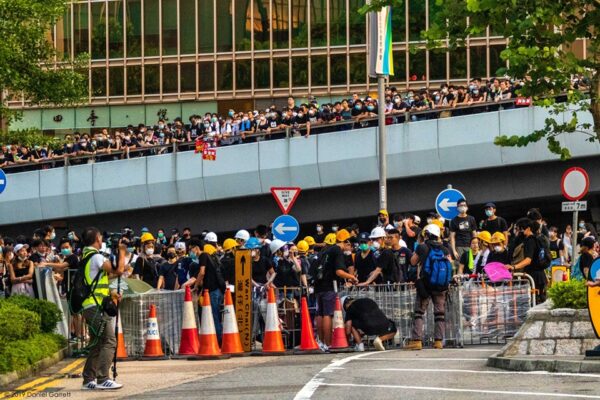
Mass organisation needed
The key lesson for the movement to draw from this is the need for real organisation. The criteria for evaluating all actions and methods, all tactical innovations, is whether they take the mass struggle forward, raise the fighting spirit and level of political understanding of the masses or set it back.
This is not to blame the young demonstrators, but to recognise the big deficiencies within the current movement, alongside its stunning mass mobilisations. Especially this concerns the lack of real organisation, the absence of mass organisations among the youth and the weakness of working class organisation.
This lack of organisation is not an ‘advantage’ for the struggle as some argue, but a handicap, and spontaneity is not an inexhaustible power source because mass movements do not simply run in one direction: there are twists, turns, and crises within every movement. What is needed is mass organisation with a democratically agreed and elected leadership that can summarise the lessons and experience of the movement – to anticipate the enemy’s manoeuvres and prepare to defeat them. The most important ingredient lacking in Hong Kong today is a fighting mass workers’ party that could begin to fill this political and organisational vacuum within the mass struggle.
Socialist Action is an active force in the Hong Kong anti-authoritarian struggle, intervening to build support for a working class and socialist alternative to today’s brutal and corrupt system. To defeat Carrie Lam’s government, the movement also needs to take on the power of the capitalist tycoons whose interests she serves.
From the beginning of Hong Kong’s return to Chinese rule, the tycoons have worked hand-in-glove with the CCP dictatorship, a phenomenon that still confuses many overseas observers, blocking any progress towards democratic elections and collaborating in the neo-liberal pillaging of Hong Kong’s resources to create bigger and bigger profits for the super-rich. If the tycoons were nervous over Lam’s extradition law, that it could impact them and their fortunes, they are now even more nervous about the mass unrest in Hong Kong. They want ‘stability’ (by which they mean repression) restored as soon as possible.
To effectively fight and organise against this regime and the bigger regime that stands behind it, a working class party is needed which links together the immediate demands of the youth and masses today against police repression, the extradition law, and the CCP’s step-by-step strangulation of Hong Kong’s partial political autonomy, with a programme to eradicate Hong Kong’s housing crisis (three out of every four 18 to 35 year-olds still live with their parents, compared to one in four in Britain), the poverty crisis, hospitals crisis and many others. This requires radical socialist policies to take control of the banks and big companies from the tycoons and CCP ‘red’ capitalists, and put these resources under democratic public ownership and control.



